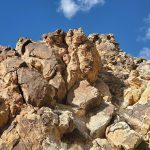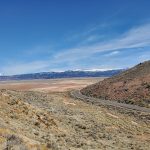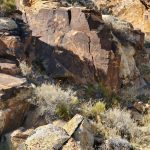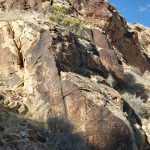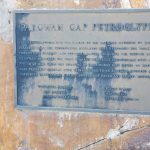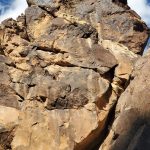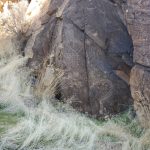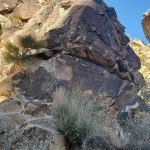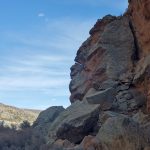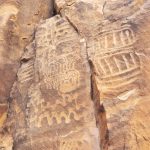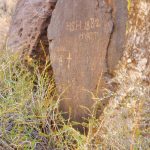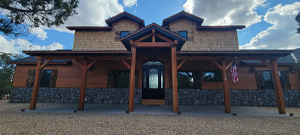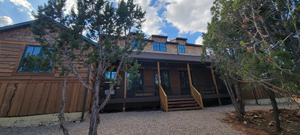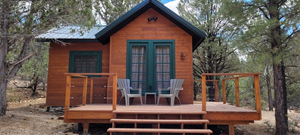Parowan Gap is paradise for petroglyph lovers. The three-mile long pass is located in Iron County, Utah, off Interstate 15 near Parowan and Cedar City. The pass is an example of a wind gap, a geological formation where an ancient river has cut through the rock and created a space. Over time, the rock rose higher from the ground and the area’s climate grew more dry. Erosion by wind and rain helped shape the valley into the waterless wind gap that exists today. A paved road now cuts in between two tall rock walls, allowing a close up look at the estimated 90 panels and 1500 figures etched into the Navajo sandstone.
Petroglyphs are images carved or etched into rock, typically exposing a different colored rock layer beneath. They were one of the earliest forms of art and record keeping. Fences have been erected to help preserve and protect the rock art. A number of interactive signs around the area help explain the presumed meaning behind some of the imagery. These signs can be found beside the sidewalks that flank the road. The proximity of the sidewalks and the road to the rock art makes the gallery accessible to nearly anyone.
Geometric designs, lizards, snakes, mountain sheep, bear claws, concentric circles, feet and human figures are some of the many drawings etched into the walls of the pass. One of the most iconic images in the collection is the Zipper petroglyph. The Zipper is said to be an inverted man with an arrow in his skull. Other parts of the elaborate design are interpreted as a map, a calendar of solar alignments, and a system of outer cairns. Deciphering the pictures is part of the fun while viewing the petroglyphs.
Our Vacation Rentals:
Save Up to 15% When You Book Directly
Today Parowan Gap has a paved parking area, a bathroom, sidewalks, and information panels. It is easy to get to and from the destination in any passenger vehicle. The short walk through the pass is flat and paved. This makes the area easy to explore for individuals of any age and fitness level; it is even wheelchair accessible.
Everyone will love wandering up and down the pass, studying each panel and providing a unique interpretation. Please mind the railings and do not touch any of the images. If hoping to capture history in photographs, it is best to avoid the late afternoon shadows cast by the looming walls. It is amazing how well the artwork has withstood the elements over the years. The petroglyphs are estimated to have been created over a period of 1,000 years.
The rock art was created by many different native tribes over time, including the Sevier-Fremonts and Southern Paiutes. A variety of different artists from different time periods has resulted in an artistic culture collision. Diverse styles intertwined across the rock create a truly unique work of art. Parowan Gap’s detailed collection of busy murals tells an intricate story of the changes in the land and its people.
Written by: Lauren Kehoe

